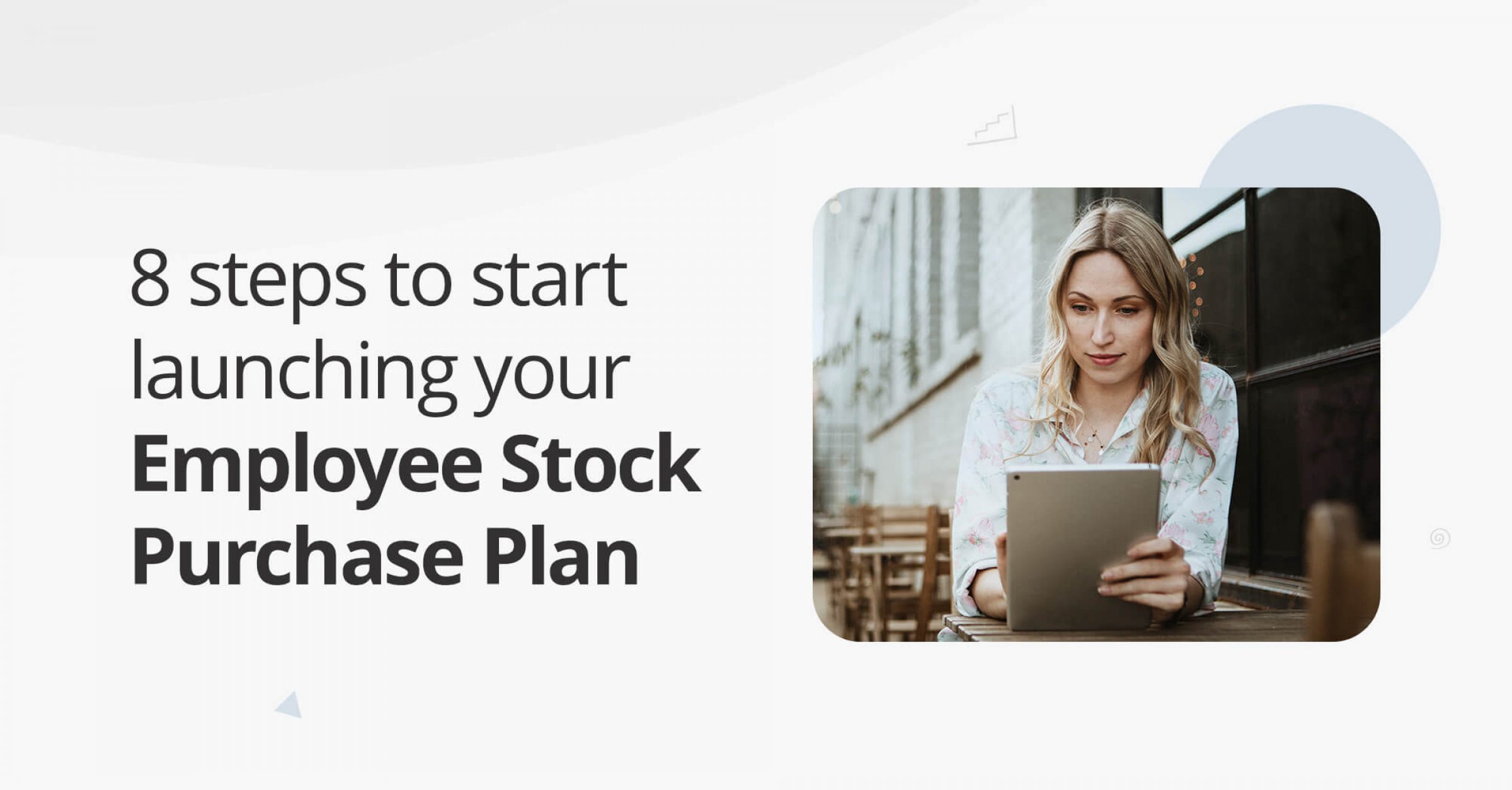An ESPP (employee stock purchase plan) is a program which allows employees to use their after-tax wages to acquire their company’s shares, usually at a discount of up to 15%, via payroll deductions. While ESPPs have proven to be beneficial for both employers and employees, rolling out a plan can be confusing sometimes.
Together with one of our Certified Equity Professionals (CEP), John Bagdonas, we’ll look at the stages you need to go through to introduce an ESPP in your company, including important items to help navigate the process and things you should consider.
- Define your ESPP goal
- Design and research for your ESPP
- Get approval
- Set up your plan details & rules (partner with a service provider)
- Plan the content of your communications
- Enrollment stage
- Track all events and administer on a daily basis
- Measure, review and improve
Step 1. Define your ESPP goal
Every plan starts with a goal, or series of goals. Having clear, specific goals set out in writing will help ensure the plan is purposeful and aligned with the needs and expectations of your business. It can also help you easily navigate during research and design phases. More importantly, if you know what you want to achieve then you’ll know how to measure the success of the plan.
Here are some common goals which businesses often focus on:
- Foster an employee ownership culture
- Stay competitive to attract talent
- Improve employee retention
- Facilitate a means for employees to buy company stock
- Enhance employees’ financial wellness and security
- Offer employees shares to help unite the global workforce
Step 2. Design and research for your ESPP
2i) Design your plan
In the ESPP design phase, there are a number of plan rules you need to consider. Don’t rush into making decisions because your plan’s success significantly relies on its features. So, before establishing the rules, take a moment to read our ‘’employee stock purchase plan’’ guide. Get familiar with how an ESPP works and all the nuts and bolts.
- Source of ESPP shares: Newly issued shares, treasury shares, or open-market purchases or combined
- Plan type: Qualified and non-qualified (Read more: Qualified vs non-qualified ESPP)
- Qualified plan: Provides tax benefits but comes with more restrictions.
- Non-qualified plan: Provides more flexibility in plan design but doesn’t qualify for the same tax benefits as the qualified one.
- Eligibility: For a qualified plan, you can exclude certain employee groups although an ESPP is an all-employee program. (Read more: ESPP explained)
- Plan discount: up to a 15% discount off the purchase price under a qualified plan (Non-qualified plans allow for an even higher discount or matching shares)
- Lookback provision: Allows the plan discount to be applied to the stock price either at the purchase date or the grant date, whichever is lower. (Read more: ESPP explained)
- Automatic rollover: Occurs in a plan with a long offering period.
If the stock price decreases on a purchase date, a rollover cancels the remaining purchase periods in the offering period and re-enrolls everyone in a new offering based on the lower price. - Length of offering period: Commonly 6 months, 12 months, or 24 months. The maximum offering period length under a qualified plan is 27 months.
- ESPP dividends: Will purchased shares receive dividend reinvestment?
- Annual contribution limit: $25,000 (for the qualified plan only)
- Others: Do you allow your participating employees to change their contributions or withdraw/suspend the plan during the offering period? Do you have any plan or share restrictions, e.g. holding periods to prevent employees from selling the shares right after the purchase?
2ii) Do your research
When making decisions on these plan rules, you should always refer back to your own business goals and also consider what other companies are offering. It’s a best practice, if not a necessity, to conduct market research to discover the practices in your industry and look to benchmark against them. For example, in the 2023 ESPP survey conducted by NASPP and Deloitte,
- 85% of companies offer a 15% discount (up from 70% in 2020).
- 83% of companies offer a lookback provision (up from 64% in 2020).
- 57% of companies offer a 6-month offering period (up from 49% in 2020), and 13% of companies offer a 12-month offering period (up from 8%)
Knowing that most companies offer a 15% discount and a lookback provision, your plan is unlikely to be attractive if you don’t measure up.
In addition, you may also want to involve internal stakeholders earlier to help refine your proposed plan and identify any roadblocks that you can’t see. These stakeholders could include the Payroll, HR, Finance, Tax and Legal departments, which may be involved in the plan implementation and or administration. If you can get their support at this earlier stage, it will help to make the launch of your ESPP smoother.
Also, don’t forget to look into local laws and regulations, etc., if you plan to launch an ESPP for your global employees. Your global ESPP design will heavily depend on your research in each jurisdiction. If you partner with an ESPP service provider, they can help you navigate the requirements specific to each jurisdiction.
Step 3. Get approval (qualified plan only)
An ESPP plan needs to be approved by the stockholders of the granting corporation within 12 months before or after the date such a plan is adopted according to I.R.C. § 423(b)(2). If you’ve decided on a non-qualified ESPP, this step is not necessary.
This process can be done via an annual general meeting (AGM), meaning you need to know when it is so you can allow enough time to secure shareholder approval before the launch. To streamline this process, engage with them in advance to discuss plan specifics and seek their buy-in.
For public companies, make sure to register the ESPP shares with the Securities and Exchange Commission (SEC) on Form S-8 once you’ve obtained shareholder approval.
Step 4. Set up your plan details & rules
While it’s possible to implement the plan in-house using a spreadsheet, doing so can easily lead to human errors and the circulation of multiple document versions internally.
If you leverage an ESPP software provider like J.P. Morgan Workplace Solutions, you and your stock plan admin team can rely on our experienced implementation team to do it by the strict data protection rules. They will bulk import all of your plan rules along with the data of your eligible employees into the system. It will then start to automatically operate the plan based on the configured settings. This automated approach will improve the efficiency and accuracy of plan management, and scale with your company as your business and ESPP plan grow.
At this stage, your stock plan admin team will also be able to work closely with the provider to perform testing on multiple items like an employee portal, file formatting and application integration.
We have also developed a handy checklist to help you create and launch an ESPP.
Download Checklist Now: Launching ESPP Step by Step
Step 5. Plan the content of your communications
Now that you’ve got a well-designed plan and an automated management system you might think it’s time to officially launch the plan, right?
Not quite, before you officially launch the plan you will need to ensure that you have a communications plan in place, as this will help with the long-term success of your ESPP. Remember, if your employees don’t understand what it is and how it works, they won’t enroll.
A well-designed communication strategy can help to improve the ESPP enrollment rate. Make sure your employees are regularly informed about the plan, starting right from the enrollment phase, through the purchase period and to the purchase date. For each phase, tell them the key dates, actions they need to take and things to consider. It’s important to keep the communications simple, clear and visual – in a way your people can learn best.
Step 6. Enrollment stage
You should allow enough time for your employees to enroll – usually two to three weeks. If this period is too short, they won’t have time to do research and ask any questions they may have.
If you partner with an ESPP service provider, make use of their online enrollment system, as this will be more effective than paper forms in improving plan participation. It can also save you time, reduce human errors, track the instant enrollment rate and share contracts easily with participants.
Step 7. Track all events and administer on a daily basis
While it may appear to be the responsibility of the stock plan team, the administration process involves various departments, including HR, Payroll, Finance, and Legal.
- HR oversees employee benefits and incorporates ESPP as part of the recruitment process. They’re also part of the communication strategies for your ESPP.
- Payroll handles wage deductions. If your employees make ESPP contributions via payroll deductions, this team will be heavily involved within ESPP.
- Finance takes care of expensing, forecasting, corporate tax deductions etc, so they’re essential in your company’s ESPP to calculate compensation expenses for your ESPP etc
- Legal is responsible for contract review and plan interpretation. If your plan is launched in multiple countries, your legal workload will be multiplied.
ESPP administration is a complex process where many departments can touch the plan during implementation and/or ongoing administration. As mentioned in step 2, bringing in these key stakeholders early on can help to address their concerns sooner, thereby making the administration process more efficient.
Contact us if you want to understand more about how to administer your ESPP. Our award-winning, automated software together with a team of certified equity professionals can make ESPP administration simplified.
Step 8. Measure, review and improve
Launching an ESPP is not the end of the process; it is just the beginning. Remember to continuously measure and review the performance of your ESPP to identify areas for improvement.
At J.P. Morgan Workplace Solutions, we have a dedicated team who can walk you through from goal setup and plan design to implementation and on-going administration. Get in touch today to find out more about how we could help you decide what’s the best approach for you.
By visiting a third-party site, you may be entering an unsecured website that may have a different privacy policy and security practices from J.P. Morgan standards. J.P. Morgan is not responsible for, and does not control, endorse or guarantee, any aspect of any linked third-party site. J.P. Morgan accepts no direct or consequential losses arising from the use of such sites.
This publication contains general information only and J.P. Morgan Workplace Solutions is not, through this article, issuing any advice, be it legal, financial, tax-related, business-related, professional or other. J.P. Morgan Workplace Solutions’ Insights is not a substitute for professional advice and should not be used as such. J.P. Morgan Workplace Solutions does not assume any liability for reliance on the information provided herein.



